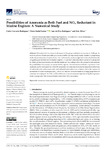Possibilities of Ammonia as Both Fuel and NOᵪ Reductant in Marine Engines: A Numerical Study

Ver/
Use este enlace para citar
http://hdl.handle.net/2183/29420
A non ser que se indique outra cousa, a licenza do ítem descríbese como Atribución 4.0 Internacional
Coleccións
- Investigación (EPEF) [592]
Metadatos
Mostrar o rexistro completo do ítemTítulo
Possibilities of Ammonia as Both Fuel and NOᵪ Reductant in Marine Engines: A Numerical StudyData
2022-01Cita bibliográfica
Rodríguez, C.G.; Lamas, M.I.; Rodríguez, J.d.D.; Abbas, A. Possibilities of Ammonia as Both Fuel and NOᵪ Reductant in Marine Engines: A Numerical Study. J. Mar. Sci. Eng. 2022, 10, 43. https://doi.org/10.3390/jmse10010043
Resumo
[Abstract] Nowadays, the environmental impact of shipping constitutes an important challenge. In order to achieve climate neutrality as soon as possible, an important priority consists of progressing on the decarbonization of marine fuels. Free-carbon fuels, used as single fuel or in a dual-fuel mode, are gaining special interest for marine engines. A dual fuel ammonia-diesel operation is proposed in which ammonia is introduced with the intake air. According to this, the present work analyzes the possibilities of ammonia in marine diesel engines. Several ammonia-diesel proportions were analyzed, and it was found that when the proportion of ammonia is increased, important reductions of carbon dioxide, carbon monoxide, and unburnt hydrocarbons are obtained, but at the expense of increments of oxides of nitrogen (NOᵪ), which are only low when too small or too large proportions of
ammonia are employed. In order to reduce NOᵪ too, a second ammonia injection along the expansion stroke is proposed. This measure leads to important NOᵪ reductions.
Palabras chave
Productos químicos
Amoníaco
Desarrollo sostenible
Máquinas marinas
Ammonia
Emissions
Decarbonization
Marine engines
Amoníaco
Desarrollo sostenible
Máquinas marinas
Ammonia
Emissions
Decarbonization
Marine engines
Versión do editor
Dereitos
Atribución 4.0 Internacional
ISSN
2077-1312






